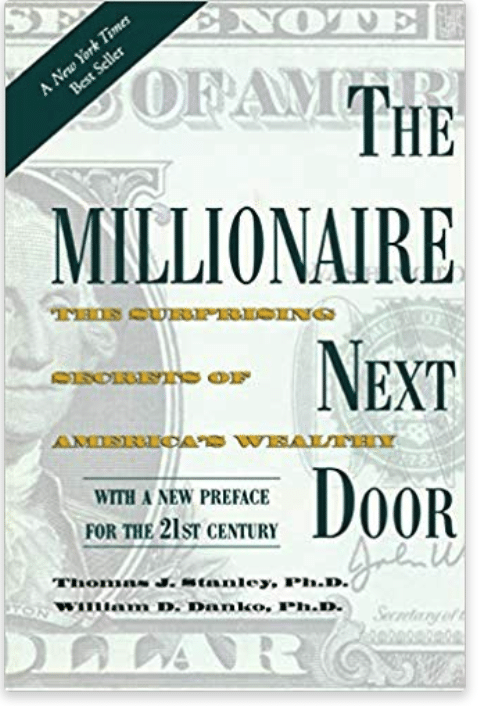High income debt. The phrase seems to contradict itself, but for far too many high income earners, debt is still one of the biggest factors in financial struggle.
In fact, a quarter of families that earn north of $150,000 still live paycheck to paycheck, according to a Nielsen study. That number increases to nearly a third who earn between $50,000 and $100,000 a year – middle class America.
Worse, according to a GoBankingRates study, almost 25% of folks who earn more than $150,000 a year have less than $1,000 in their bank account.
Think about that number for a minute. Less than $1,000.
And, Americans with a net worth of $100,000 to $199,999 are much more likely to carry credit card debt, which is arguably the most debilitating type of debt in existence. The interest rates are high and temptation to spend money on credit is always there.
Especially when you think that you have a lot of money.
It’s clear that high income earners are not immune to financial struggles, including debt. But, why do those who earn a high income struggle with money when they appear to have so much of it?
In a previous life, I was very much a high income spender. I sat squarely in the middle of the curse of pseudo affluence.
There are 5 primary reasons why so many high income earners struggle to build wealth despite big salaries.
The 5 Major Causes of High Income Debt
1: High income earners equate high income with high wealth

In the book “The Millionaire Next Door“, Dr. Thomas Stanley studied high net worth individuals for many years and found a striking similarity among them: most wealthy people don’t spend money like you’d think.
In fact, those with a high net worth typically live in modest homes and drive normal cars. Wealthy people – people with a lot of money, tend not to be the ones driving expensive luxury cars.
Instead, Stanley found BMW, Mercedes and other luxury car drivers who “look the part” tend to be high-income earners, but not necessarily those with a high net worth.
In other words, they make a lot of money but don’t necessarily have a lot of money.
“Many people who live in expensive homes and drive luxury cars do not actually have much wealth. Then, we discovered something even odder: Many people who have a great deal of wealth do not even live in upscale neighborhoods,” Stanley wrote.
The problem is high incomes trick people into thinking they are rich or can afford practically anything.
But as we’ve already seen, the numbers don’t agree.
When high income earners spend the large majority of what they make, they rack up debt and live the high life under the false assumption that they can afford it.
They become a part of the “pseudo affluent”.
The pseudo affluent
The pseudo affluent are high income earners who spend the majority of what they earn on luxury items designed to make them look, feel and appear rich and successful.
The pseudo-affluent generally:
- Earn a high-income, but spend the majority of what they make
- Wear expensive suits or carry Louis Vuitton purses
- Drive high-end luxury or sportscars like BMWs, Porsches, and Mercedes
- Genuinely believe that rich people act rich
Naturally, this does not mean that everybody who drives a BMW is pseudo affluent. The world isn’t black and white enough to make such a concrete statement.
However, those who do spend the vast majority of high incomes DO tend to drive these cars and live in wealthy neighborhoods to display their wealth.
“Many are good people, well-educated and perhaps earning a six-figure income,” writes Alexander Green, author of the book Beyond Wealth: The Road Map to a Rich Life. “But they aren’t balance-sheet rich because it’s almost impossible for most workers – even those who are well paid – to hyper-spend on consumer goods and save a lot of money.”
2: High incomes cause (and enable) lifestyle inflation
High income earners spend more because they make more, creating an expensive lifestyle that needs a high income and endless credit cards just to maintain itself.
And funding expensive lifestyles – even for those who earn a great deal of money, very often produces credit card debts that can quickly spin completely out of control.
An Experian report found that the average American carries a $6,200 credit card balance, making it tough to pay off from month-to-month even for those with high incomes.
“Those with a net worth between $100,000 and $199,999 are the most likely to carry credit card debt, followed by people with a net worth between $200,000 and $1 million,” wrote CNBC.

A lot of us struggle with lifestyle inflation.
We start making more money and, in turn, we begin spending the majority of what we earn – simply because we have it to spend.
The causes of lifestyle inflation include:
- Earning progressively more money each year, with bonuses and raises, which provides us with extra cash to spend,
- We fund expensive vacations and huge purchases with all that “extra” money that we make year-to-year,
- Many work jobs that expect us to look successful, creating a wicked cycle of earn-and-spend (more on this below), and
- We try to keep up with our coworkers by matching (or exceeding) their level of spending on luxury items
As our incomes increase, so do our lifestyles.
In 2015, for example, CNBC reported that millionaires plan to spend $13,000 on vacations – in that year alone!
What’s the problem with that? If we spend the majority of the money that we bring in, we trap ourselves into a position where we NEED a high income, year after year, just to maintain the lifestyle that we built over the previous year.
High spending habits force so many big salaried households into a destructive debt-focused lifestyle that needs a high income to fund.
What happens to our lifestyle after that income stops?
3: High incomes often begin with steep education-related debt
I spoke with a doctor a couple of years ago who told me something that I’ll never forget.

“When I started out with a net worth of negative $208,000 at the end of training,” Jimmy Turner, The Physician Philosopher, told me, “one of the most helpful things was realizing that the panhandler on the street or the toddler with a few dollars in their piggy bank (and no debt to their name) is wealthier than I was.”
This doctor understood that debts eat away at big salaries, especially when high income earners like doctors or lawyers begin their career saddled with hundreds of thousands of dollars of debt.
The numbers are startling. The average 4-year medical school will cost students nearly $190,000 after all is said and done. And, almost a quarter of medical school students will start their careers with more than $200,000 in debt.

While it’s true that many successful doctors earn substantially more during their careers than they paid in medical school, that’s not always true. And when malpractice insurance and lawsuits are added in, those monthly expenses, required to even hold the job, eat a good portion of high incomes.
The average cost for malpractice insurance is $7,500 a year, but specialized professions like surgeons pay upwards of $50,000.
Doctors aren’t the only ones paying substantial fees and shouldering big debts to work in an high income career field.
Did you know that only 23% of law school grads say that their education was worth the cost? Law students will pay more than $60,000 each year to attend a Top 10 law school.
The average law school costs $43,000 a year.
Business school students will pay almost $60,000 for the average two-year MBA program, though the top business schools will saddle students with over $100,000 in debt.
High income earners who begin their careers deep in debt are digging themselves out of a hole. Though the potential to more than make up for their education-related debts is good, it doesn’t always work out that way.
4: They work jobs that implicitly require “looking the part“

One of the most insidious elements of earning a high income is an expectation of looking like you’re rich, successful, accomplished.
And more times than not, this unwritten job requirement forces high income earners to spend money on expensive suits, nice cars and fancy watches because that’s a part of the job.
And, you’re expected to do it.
After all, research shows that “attractive” and put-together men and women earn 3 to 4% more than the rest. They are also more likely to be hired faster and get promoted sooner.
The curse of “looking the part” is more common than you might think. In a society that prioritizes the superficial, accomplished lawyers, successful doctors and prosperous businesspeople don’t tend to drive up to a client meeting in a beat-up, 1995 Camry.
Why? Because of the impression that other people get when they see someone driving an old and inexpensive car.
- Will a beat up car make my clients think less of me?
- Do I appear less successful, less intelligent or less influential if I drive a normal car rather than an expensive import?
- Maybe that 7-series Bimmer makes me look like if I win all my cases or run highly lucrative businesses that change the world?
This culture of looking successful devolves into a wicked cycle of consumption, fueled through the drive to be more successful and earn more money.
Through this reinforcement, high income earners are conditioned to believe that high consumption lifestyles – enabled through high incomes, are expected. Necessary.
In many industries, looking successful is an implied requirement to continue building high income careers. If you don’t do it, you won’t succeed in that profession.
“Allocating time and money in the pursuit of looking superior often has a predictable outcome: inferior economic achievement,” wrote Dr. Thomas Stanley. “What are three words that profile the affluent? FRUGAL FRUGAL FRUGAL.”
5: Their cost of living is much too high (house poor, child care, etc)

Our home mortgage is one of the biggest expenses that Americans face. And for most of us, it’s our largest expense.
The average median cost of housing is nearly $1,500 a month, easily gobbling up a quarter of our income each and every month.
“The average married couple with children between the ages of 6 and 17 spends 32 percent of their budget on housing, and single people spend almost 36 percent, according to data from the Bureau of Labor Statistics,” Consumer Reports wrote.
And, that’s considerably more than the recommend 25 percent rule often cited by financial advisors.
If you’re saddled with debt, even spending 25% of your monthly take-home pay might over-extend your spending power, especially if you’re unable to put money aside for your future retirement.
This means you’re “house poor”.
In many high income households with kids, both parents work. The average cost of a nanny is almost $19 an hour, though in some areas, nannies demand upwards of $25 an hour.
Believe it or not, 6 in ten nannies receive annual bonuses, too.
Throw in additional costs like landscaping and house cleaning, expensive restaurant visits and pricey alcohol, a high income encourages high consumption because we think we can afford it.
The High Income Trap
Those of us who earn high incomes also enjoy a huge potential to save and set us up for a comfortable retirement. But, that doesn’t necessarily mean that most high income earners are doing that.
And, it also doesn’t mean it’s easy for us to save. We get conned into believing that we’re rich because we earn big money.
Many business industries are designed around perception, and if we aren’t driving up to client meetings in a new Porsche Spyder, then we aren’t worth talking to. We are not successful enough.
Education debt destroys financial security in high-income careers if we begin spending the majority of our income too soon. After all, the Dr. Jones’s are driving high-priced cars and living in big homes.
Why can’t I?



